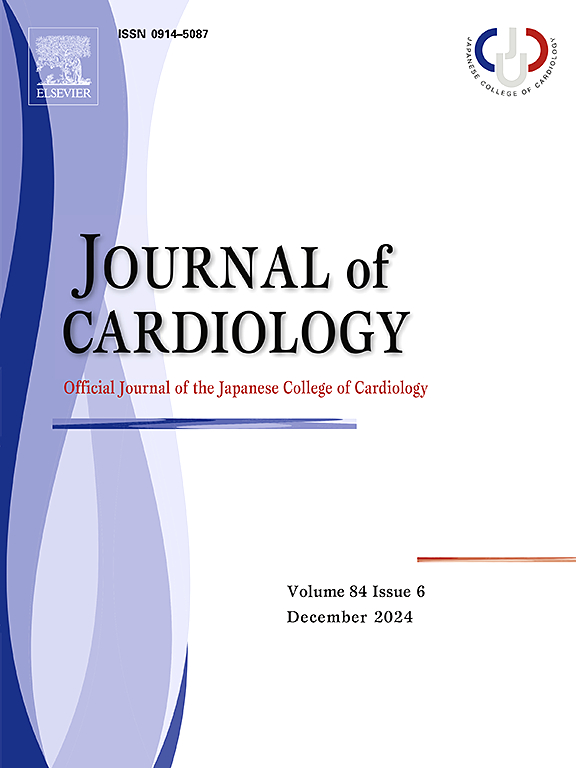Clinical characteristics and short-term outcomes in patients with cardiogenic shock undergoing mechanical circulatory support escalation from intra-aortic balloon pump to impella: From the J-PVAD registry
IF 2.5
3区 医学
Q2 CARDIAC & CARDIOVASCULAR SYSTEMS
引用次数: 0
Abstract
Background
An escalation strategy from intra-aortic balloon pump (IABP) to Impella (AbioMed, Danvers, MA, USA) is proposed in patients with cardiogenic shock (CS) refractory to IABP therapy, but its clinical data are lacking. This study aimed to elucidate the clinical characteristics and short-term outcomes in patients undergoing IABP-Impella escalation.
Methods and results
From the Japanese nationwide registry of Impella (J-PVAD), a total of 2578 patients with CS receiving Impella support were classified into the IABP-Impella group (n = 189) or the Primary Impella group (n = 2389). We applied 1:3 propensity score (PS) matching, selecting 185 patients and 555 patients, respectively. Before matching, the IABP-Impella group presented longer shock-to-Impella time, worse laboratory data, and more frequent inotropes and pulmonary artery catheter use than the Primary Impella group. After matching, the baseline characteristics were well-balanced. Regarding the 30-day clinical outcomes in the PS-matched cohort, there were no significant differences in the rates of mortality and major complications (a composite of bleeding, hemolysis, infection, stroke, myocardial infarction, limb ischemia, and vascular injury) between the groups. However, The IABP-Impella group showed a significantly higher rate of infection (10.3 % vs. 5.6 %, p = 0.042) and additional mechanical circulatory support use (34.1 % vs. 23.8 %, p = 0.008) than the Primary Impella group.
Conclusions
Compared to patients with primary Impella support, those undergoing IABP-Impella escalation showed similar 30-day mortality and major complications despite poorer clinical conditions before Impella support and a more complicated clinical course after Impella insertion.

从主动脉内球囊泵到Impella的机械循环支持升级的心源性休克患者的临床特征和短期疗效:来自 J-PVAD 注册。
背景:有人建议对 IABP 治疗难治的心源性休克(CS)患者采取从主动脉内球囊反搏泵(IABP)升级到 Impella(AbioMed,丹佛斯,马萨诸塞州,美国)的策略,但缺乏临床数据。本研究旨在阐明接受 IABP-Impella 升级治疗的患者的临床特征和短期疗效:从日本全国 Impella 登记(J-PVAD)中,共有 2578 名接受 Impella 支持的 CS 患者被分为 IABP-Impella 组(n = 189)或初级 Impella 组(n = 2389)。我们采用 1:3 倾向评分 (PS) 匹配,分别选择了 185 名患者和 555 名患者。匹配前,IABP-Impella 组比 Primary Impella 组休克到 Impella 时间更长、实验室数据更差、肌注和肺动脉导管使用更频繁。匹配后,基线特征非常均衡。关于 PS 匹配组群的 30 天临床结果,两组之间的死亡率和主要并发症(出血、溶血、感染、中风、心肌梗死、肢体缺血和血管损伤的综合征)发生率没有显著差异。然而,IABP-Impella组的感染率(10.3% vs. 5.6%,p = 0.042)和额外使用机械循环支持的比例(34.1% vs. 23.8%,p = 0.008)明显高于初级Impella组:结论:与接受初级Impella支持的患者相比,接受IABP-Impella升级治疗的患者的30天死亡率和主要并发症相似,尽管Impella支持前的临床状况较差,Impella插入后的临床过程更复杂。
本文章由计算机程序翻译,如有差异,请以英文原文为准。
求助全文
约1分钟内获得全文
求助全文
来源期刊

Journal of cardiology
CARDIAC & CARDIOVASCULAR SYSTEMS-
CiteScore
4.90
自引率
8.00%
发文量
202
审稿时长
29 days
期刊介绍:
The official journal of the Japanese College of Cardiology is an international, English language, peer-reviewed journal publishing the latest findings in cardiovascular medicine. Journal of Cardiology (JC) aims to publish the highest-quality material covering original basic and clinical research on all aspects of cardiovascular disease. Topics covered include ischemic heart disease, cardiomyopathy, valvular heart disease, vascular disease, hypertension, arrhythmia, congenital heart disease, pharmacological and non-pharmacological treatment, new diagnostic techniques, and cardiovascular imaging. JC also publishes a selection of review articles, clinical trials, short communications, and important messages and letters to the editor.
 求助内容:
求助内容: 应助结果提醒方式:
应助结果提醒方式:


